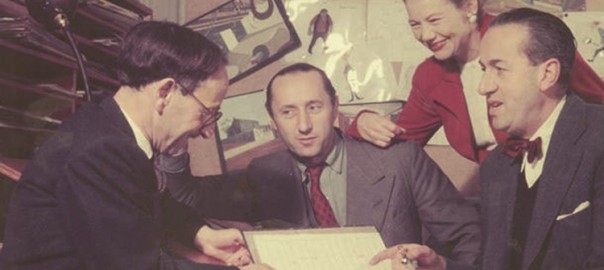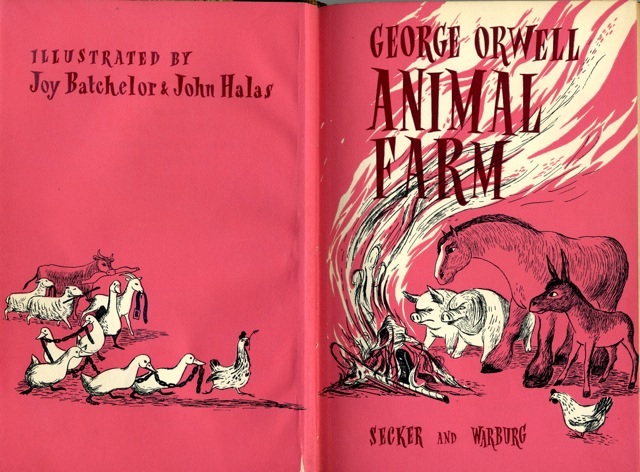Book Review: A Moving Image – Joy Batchelor 1914-91 – Artist, Writer and Animator
This comprehensive and personal look at the professional life of Joy Batchelor, edited and published in what would have been her centenary year by her daughter Vivien Halas, combines sections by Brian Sibley, Jez Stewart, Claire Kitson, Jim Walker, Paul Wells and Vivien herself.
 A Moving Image provides an overview of Joy’s life, a detailed look at her career and a fresh focus on her working relationship with John Halas (János Halász), the Hungarian born animator who became her husband and the father of her children, as well as her lifetime collaborator in Halas & Batchelor. They made a formidable team, achieving world renown, and were undoubtedly ‘the’ early pioneers and innovators in the field of animation, certainly in Britain and arguably in Europe.
A Moving Image provides an overview of Joy’s life, a detailed look at her career and a fresh focus on her working relationship with John Halas (János Halász), the Hungarian born animator who became her husband and the father of her children, as well as her lifetime collaborator in Halas & Batchelor. They made a formidable team, achieving world renown, and were undoubtedly ‘the’ early pioneers and innovators in the field of animation, certainly in Britain and arguably in Europe.
 “Halas & Batchelor gave us all the lead. In our early days at Aardman we could only dream of aspiring to their stature.” – Peter Lord, Aardman Animation.
“Halas & Batchelor gave us all the lead. In our early days at Aardman we could only dream of aspiring to their stature.” – Peter Lord, Aardman Animation.
Most importantly, this informative book seeks to redress the balance and give full credit to a great unsung heroine, a woman described by BFI National Archive curator Jez Stewart as “the most successful woman in British animation to date. Her forty-year career as first an animator, but then very quickly as a writer, producer, director, and joint creative head at what was one of the biggest animation studios in Western Europe, has never been matched, and probably never will.”
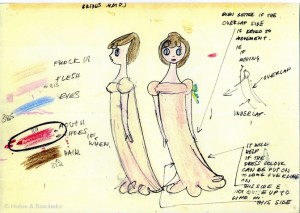 In the past, talented women in every professional and creative field have all too often been sidelined, forgotten or blatantly written out of history. In the introductory section author, broadcaster and film critic Brian Sibley opens with an ‘Ode to Joy’ acknowledging his own unwitting earlier bias when covering the Halas & Batchelor studio’s story.
In the past, talented women in every professional and creative field have all too often been sidelined, forgotten or blatantly written out of history. In the introductory section author, broadcaster and film critic Brian Sibley opens with an ‘Ode to Joy’ acknowledging his own unwitting earlier bias when covering the Halas & Batchelor studio’s story.
Claire Kitson, a writer on animation and ex commissioning editor for Channel 4 animation, provides further analysis on the thorny issue in her contribution ‘A Woman’s Place’. Towards her conclusion she also notes that “Joy was certainly the woman who changed the British animation industry the most, and for the better. Her professionalism, perspective and tireless effort was a key driving force in reinvigorating the moribund pre-World War Two British animation scene, to become an exciting and dynamic golden age for the industry in the 1950s.”
The story was invariably told from a largely Halas orientated perspective and might still be without this book. Vivien is uniquely placed to provide interesting personal background, with a balanced view of the working dynamic. What shines through in both her writing and her carefully edited contributors’ pieces is the immense respect held for Joy, not just as an animator, but also as an artist, writer and visionary creative. She excelled in communication too, translating Halas’ undeniable talent into a format amenable to the context in which they worked. “She had to use her knowledge of England and the English, to facilitate ways in which the Eastern European aesthetics so favoured by Halas might be made acceptable to, and effective for, British companies and audiences.” – Paul Wells, author, academic at the animation academy at Loughborough University.
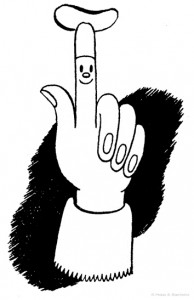 It becomes clear that the business could never have functioned, let alone thrived without Joy. In the earlier days, it was thanks to her contact, Jack Beddington, the influential publicity director of Shell, later appointed as head of the Ministry of Information’s (MOI) film division, that they received a steady flow of work throughout the war. John estimated that they made some 70 films during this period, many of them short 90 second public information inserts for cinema newsreels. With this degree of exposure they soon became household names in Britain.
It becomes clear that the business could never have functioned, let alone thrived without Joy. In the earlier days, it was thanks to her contact, Jack Beddington, the influential publicity director of Shell, later appointed as head of the Ministry of Information’s (MOI) film division, that they received a steady flow of work throughout the war. John estimated that they made some 70 films during this period, many of them short 90 second public information inserts for cinema newsreels. With this degree of exposure they soon became household names in Britain.
This reputation was cemented in 1954 with the launch of their groundbreaking film, the very first British cartoon feature: Animal Farm, George Orwell’s extraordinary novel, brought to life in animation. This coincided with the publication of the famous fable in print in the same year.
Brian Sibley notes, from his first meeting with Joy in 1980: “We discussed the conflicting demands of art and commerce and talked, at some length, about ‘Animal Farm’, not just the film but also the illustrated edition of the book … in which – a rare event – Joy got first credit ahead of John!”
Answering questions relating to this review, Vivien informs me that this is purely for alphabetical reasons. She adds: “Her name always came after John’s because the company was called Halas & Batchelor Cartoons. I imagine they felt it sounded better and was more commercial. I don’t think she minded except towards the end of her career when she found that she was isolated and often not mentioned at all. Joy liked working in a team and in the studio. In the beginning she and John were in perfect sync and you could hardly tell their drawing styles apart, except that hers was more fluid and expressive.”
Animal Farm the film does credit Joy a little more fully (although as Vivien says, her mother wrote the script not once but with at least 7 revisions), recognising her huge contribution to virtually every aspect of this beautiful and compelling film. It has lost none of its allure over time and will soon be relaunched in HD – see the original trailer here:
While much of A Moving Image charts Batchelor’s exceptional career in animation, which later led to a teaching role, her other talents, including as a book and magazine illustrator, are also well documented. Jim Walker, an academic specialising in illustration at UCA Farnham and Canterbury, highlights many in his section of the book, ‘A Gifted Illustrator’. There were extensive contributions to advertising, marketing and editorial projects and illustrative work for a series of cookery books, fashion magazines and newspapers.
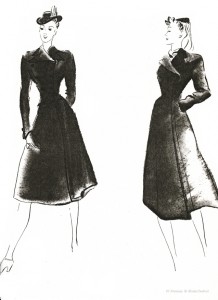 Paul Wells succinctly summarises Joy’s multiple talents in his chapter of the book ‘Joy, Britain Needs You’. “Her understanding of what commercial clients required was astute, seeing her work in a way that drew emphatic attention to the product at the conclusion of a commercial by ensuring that a visually and textually playful opening narrative entertained the viewer rather than simply instilling a didactic message. This was especially important not merely in the context of advertising but in more ideologically-charged films, and most particularly her work on the studio’s masterpiece ‘Animal Farm’ (1954).”
Paul Wells succinctly summarises Joy’s multiple talents in his chapter of the book ‘Joy, Britain Needs You’. “Her understanding of what commercial clients required was astute, seeing her work in a way that drew emphatic attention to the product at the conclusion of a commercial by ensuring that a visually and textually playful opening narrative entertained the viewer rather than simply instilling a didactic message. This was especially important not merely in the context of advertising but in more ideologically-charged films, and most particularly her work on the studio’s masterpiece ‘Animal Farm’ (1954).”
One of the later projects, a film originally commissioned by the British Life Assurance Trust is a perfect vehicle for Joy’s communication and artistic skills as well as her wit. The Five (1970) , is a health information film concerning foot care for pre-teen and teenage girls. Joy swiftly grasps the fact that humour and a light approach will be the most persuasive in convincing young girls that yearned for fashion shoes may not be the best choice for young feet. She cleverly creates characters out of the five toes, personifying them as sisters. Needless to say that the little and big sisters at either end suffer the most after a long day out followed by a visit to a disco, and the middle toes are just a tad disgruntled too. “Playful and entertaining, the film uses the particular capacity in animation for anthropomorphism to speak to its audience without patronising or offending them.” – Paul Wells.
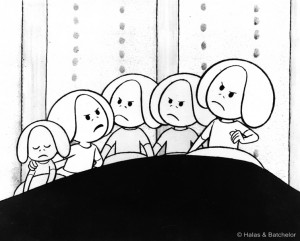 As Vivien concludes during our conversation: “Joy liked projects to have content and meaning.”
As Vivien concludes during our conversation: “Joy liked projects to have content and meaning.”
Watch The Five created and directed by Joy Batchelor:
As the title suggests in an undoubtedly deliberate double entendre, A Moving Image is a heartfelt and overdue tribute to a truly inspiring woman – this limited numbered edition book is definitely worth having on your shelf.
There is a detailed filmography at the end listing over 100 films. The book also contains plentiful illustrations of Joy’s work, including strips from some of the key films.
You can find out more about the The Moving Image and meet some of those involved in its creation, including Vivien Halas, at the Hungarian Cultural Centre’s forthcoming event:
Celebrating Joy Batchelor, FILM, SCREEN TALK & BOOK SIGNING
1 October 2014, 7pm
Hungarian Cultural Centre
10 Maiden Lane, Covent Garden, London WC2E 7NA
Animal Farm in HD at NFT 3
London Animation Film Festival
The newly restored HD version of Animal Farm will be premiered at NFT3 Southbank on 12 October 2014, 12.30
Further events are planned in Bradford and Brighton.
Learn more about Joy Batchelor, John Halas and their work, check other forthcoming events and find out where to buy the book: Halas & Batchelor
Text © Emma Boden
All photography © Halas & Batchelor Collection
Films © Halas & Batchelor Collection
NB The rights to The Five were acquired by The Wellcome Library from the British Medical Association in 2006 along with their film archive.

